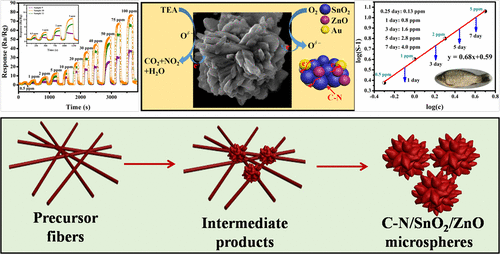当前位置:
X-MOL 学术
›
ACS Appl. Mater. Interfaces
›
论文详情
Our official English website, www.x-mol.net, welcomes your
feedback! (Note: you will need to create a separate account there.)
Novel Construction of Morphology-Tunable C–N/SnO2/ZnO/Au Microspheres with Ultrasensitivity and High Selectivity for Triethylamine under Various Temperature Detections
ACS Applied Materials & Interfaces ( IF 8.3 ) Pub Date : 2019-01-31 00:00:00 , DOI: 10.1021/acsami.8b22357 Hui Li 1 , Shushu Chu 1 , Qian Ma 1 , Yuan Fang 1 , Junpeng Wang 1 , Quande Che 1 , Gang Wang 1 , Ping Yang 1
ACS Applied Materials & Interfaces ( IF 8.3 ) Pub Date : 2019-01-31 00:00:00 , DOI: 10.1021/acsami.8b22357 Hui Li 1 , Shushu Chu 1 , Qian Ma 1 , Yuan Fang 1 , Junpeng Wang 1 , Quande Che 1 , Gang Wang 1 , Ping Yang 1
Affiliation

|
Morphology-tunable C–N/SnO2-based hierarchical microspheres with good gas sensitivity for triethylamine (TEA) have been fabricated via facile electrospinning and a subsequent calcination process. The reaction temperature and modifying calcining technology played a dominant role for the morphological evolution from precursor fibers to microspherical shapes and the formation of C–N-decorated SnO2 phase composition. C–N/SnO2/ZnO composites with tunable crystallinity, microstructure, and gas-sensing performance were strictly dependent on the added amount of Zn element. Fascinatingly, the constructed C–N/SnO2/ZnO/Au composites can not only precisely regulate the crystal size, dispersion status, loading position, and content of Au nanoparticles but also display excellent gas-sensing properties with ultrasensitivity and high selectivity under various temperature detections. The response of C–N/SnO2/ZnO/Au composites can reach up to approximately 1970, calculated to be 121.6 and 23.6 times for 50 ppm TEA molecules at optimal conditions compared with C–N/SnO2 and C–N/SnO2/ZnO microspheres, respectively, actually representing the highest response value at high temperatures reported to date. The superior long-aging stability of sensing behaviors and phase structures can be also observed after 1 month. More importantly, novel C–N/SnO2/ZnO/Au sensors were employed for availably detecting low-concentration volatiles released from the storage procedure of fishes at 80 °C, indicating the practical application in chemical detectors and biosensors at low temperature. The novel gas-sensing mechanisms derived primarily from the combination of phase compositions, morphologies, and unique surface/interface transfer processes of C–N/SnO2/ZnO/Au composites are presented and investigated in detail, which will contribute to the design and development of other semiconductor-based composite sensors.
中文翻译:

在各种温度检测下对三乙胺具有超灵敏性和高选择性的形态可调的C–N / SnO 2 / ZnO / Au微球的新颖构建
形态学可调的基于C–N / SnO 2的分层微球对三乙胺(TEA)具有良好的气体敏感性,这是通过容易的静电纺丝和随后的煅烧过程制备的。反应温度和改进的煅烧技术对从前体纤维到微球形的形态演变以及由C–N装饰的SnO 2相组成的形成起着主导作用。具有可调结晶度,微观结构和气敏性能的C–N / SnO 2 / ZnO复合材料严格取决于Zn元素的添加量。令人着迷的是,构造的C–N / SnO 2/ ZnO / Au复合材料不仅可以精确调节Au纳米颗粒的晶体尺寸,分散状态,负载位置和含量,而且在各种温度检测下均具有超灵敏和高选择性的优异气敏特性。C–N / SnO 2 / ZnO / Au复合材料的响应可以达到1970年左右,在最佳条件下,相对于C–N / SnO 2和C–N / SnO,对于50 ppm TEA分子,计算得出的响应是其121.6和23.6倍。2 / ZnO微球实际上分别代表了迄今为止报道的高温下的最高响应值。1个月后,还可以观察到传感行为和相结构的优异的长期老化稳定性。更重要的是,新颖的C–N / SnO 2/ ZnO / Au传感器可用于检测在80°C的鱼类存储过程中释放的低浓度挥发性物质,这表明其在低温下的化学检测器和生物传感器中的实际应用。提出并详细研究了主要由相组成,形态和C–N / SnO 2 / ZnO / Au复合材料独特的表面/界面转移过程的组合所产生的新颖的气敏机理,这将有助于设计和开发其他基于半导体的复合传感器。
更新日期:2019-01-31
中文翻译:

在各种温度检测下对三乙胺具有超灵敏性和高选择性的形态可调的C–N / SnO 2 / ZnO / Au微球的新颖构建
形态学可调的基于C–N / SnO 2的分层微球对三乙胺(TEA)具有良好的气体敏感性,这是通过容易的静电纺丝和随后的煅烧过程制备的。反应温度和改进的煅烧技术对从前体纤维到微球形的形态演变以及由C–N装饰的SnO 2相组成的形成起着主导作用。具有可调结晶度,微观结构和气敏性能的C–N / SnO 2 / ZnO复合材料严格取决于Zn元素的添加量。令人着迷的是,构造的C–N / SnO 2/ ZnO / Au复合材料不仅可以精确调节Au纳米颗粒的晶体尺寸,分散状态,负载位置和含量,而且在各种温度检测下均具有超灵敏和高选择性的优异气敏特性。C–N / SnO 2 / ZnO / Au复合材料的响应可以达到1970年左右,在最佳条件下,相对于C–N / SnO 2和C–N / SnO,对于50 ppm TEA分子,计算得出的响应是其121.6和23.6倍。2 / ZnO微球实际上分别代表了迄今为止报道的高温下的最高响应值。1个月后,还可以观察到传感行为和相结构的优异的长期老化稳定性。更重要的是,新颖的C–N / SnO 2/ ZnO / Au传感器可用于检测在80°C的鱼类存储过程中释放的低浓度挥发性物质,这表明其在低温下的化学检测器和生物传感器中的实际应用。提出并详细研究了主要由相组成,形态和C–N / SnO 2 / ZnO / Au复合材料独特的表面/界面转移过程的组合所产生的新颖的气敏机理,这将有助于设计和开发其他基于半导体的复合传感器。































 京公网安备 11010802027423号
京公网安备 11010802027423号